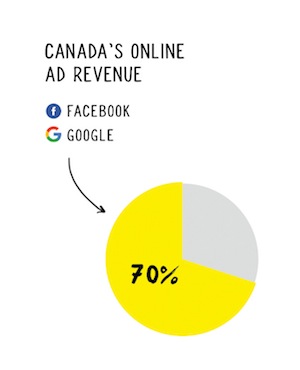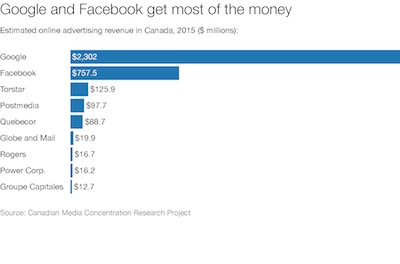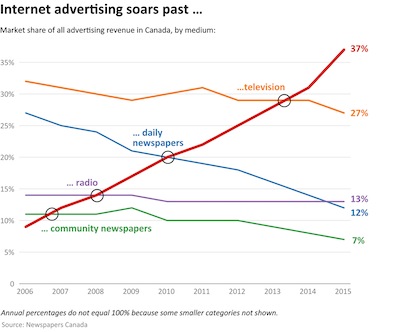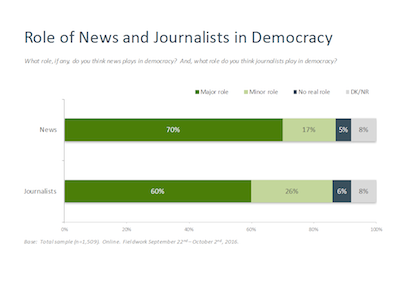The Shattered Mirror: News, Democracy and Trust in the Digital Age, released on Jan. 26 by the Public Policy Forum, shines a light on the news industry in Canada, revealing it is reaching a crisis point as the decline of traditional media, fragmentation of audiences and the rise of fake news pose a growing threat to the health of our democracy.
When the PPF began thinking about a study on the state of the news media in Canada, in early 2016, the headlines were all bad. Within a fortnight in January 2016 alone, Rogers Media and Postmedia announced new rounds of staff reductions, Torstar revealed plans to close its printing plant, and Confederation-era newspaper titles in Guelph, Ont., and Nanaimo, B.C., were shuttered, the first of six daily papers to close, merge or reduce their publishing schedules before year’s end. The situation wasn’t much better on the broadcast news side, where revenues, especially in local television, followed the downward track of the newspaper industry, inducing the Canadian Radio-television and Telecommunications Commission to step in.
 A parliamentary committee was formed. News companies and industry associations queued up with complaints of inequities in the marketplace. The Government of Canada contracted with the PPF, a non-partisan and independent think-tank, to assess the situation and make recommendations on what, if anything, should be done.
A parliamentary committee was formed. News companies and industry associations queued up with complaints of inequities in the marketplace. The Government of Canada contracted with the PPF, a non-partisan and independent think-tank, to assess the situation and make recommendations on what, if anything, should be done.
“The question for Canadian policy-makers is not whether given news outlets are in trouble, but whether democracy itself has been placed at risk in the process,” states The Shattered Mirror. “To the extent public policy has a role to play, it should be focused on maintaining the flow of information essential to a healthy society and ensuring the development of the digital arteries of the new information system – not preserving the press as we know it. The digital revolution is real, but with it have arisen challenges: fragmentation, distortion and adjusting to new business and storytelling models.”
After six months of study and discussions with close to 300 people, the report proposes recommendations aimed at ensuring that the news media and journalists continue in their role as the watchdogs over elected representatives and public institutions, and the connective tissue within communities.
 “This report is not about the journalists, with whom I feel great solidarity, but rather the role they play, and what we may be putting at risk if we are inattentive,” writes Edward Greenspon, president and chief executive author of the PPF and the report’s author. Greenspon spent more than 30 years as a journalist before joining the PPF.
“This report is not about the journalists, with whom I feel great solidarity, but rather the role they play, and what we may be putting at risk if we are inattentive,” writes Edward Greenspon, president and chief executive author of the PPF and the report’s author. Greenspon spent more than 30 years as a journalist before joining the PPF.
“[Digital] platforms, with daily audiences 10 times larger than those of major newspapers or TV broadcasters, are not just the new intermediaries of the public square but control the commanding heights of the marketplace of ideas,” the report says. “Their models are based on truth neutrality. Moreover, they only give the appearance of being a common space. Rather, they calculate and reinforce the prejudices of the like-minded, who either assign themselves to echo chambers or find themselves invisibly assigned by algorithms into filter bubbles. Both run counter to the concept of the media as an agent of common understanding.”
The dominance of Google and Facebook delivers another blow to Canada’s main providers of news: the loss of revenue with which to fund quality journalism at scale. “They pocket two of every three digital ad dollars spent in Canada and, in recent months, have generated 82% of the ads served up with digital news.
 “Google’s share of the Canadian digital market is almost 10 times that of the daily newspaper industry and 60 times that of community newspapers. A comparison of digital revenues for all newspapers and TV programs shows they bring in about one-seventh of the total of the two U.S. platform giants.”
“Google’s share of the Canadian digital market is almost 10 times that of the daily newspaper industry and 60 times that of community newspapers. A comparison of digital revenues for all newspapers and TV programs shows they bring in about one-seventh of the total of the two U.S. platform giants.”
One result of this inequity? “Since 2010, there have been 225 weekly and 27 daily newspapers lost to closure or merger in more than 210 federal ridings,” notes the report. Small market TV stations have closed and many others, like surviving newspapers, have cut service and journalistic staff. Information supplied by Canada’s main media unions points to an estimated 30% reduction in journalism jobs since 2010.
Among the 12 recommendations are proposals for a new “local mandate” for Canada’s national wire service, The Canadian Press, ensuring there are more journalistic “boots on the ground” to supplement coverage of courts, legislatures and city halls; an indigenous journalism initiative to put more resources into communities and governments that are often overlooked; the launch of a service that provides much-needed legal advice to smaller outlets providing investigative and accountability journalism; and the creation of a research institute that would examine news and democracy issues more closely, including the distribution of fake news.
The report also calls for changes to Section 19 and 19.1 of the Income Tax Act to support civic-function journalism in Canada, whether by incentivizing Canada-centred news organizations to do more reporting or, for those that don’t, creating a revenue stream to support a Future of Journalism and Democracy Fund.
 Three recommendations deal with CBC’s special role in Canadian news, including a call to relieve the CBC of the need to sell online advertising in order to promote production of civic-function journalism over chasing clicks.
Three recommendations deal with CBC’s special role in Canadian news, including a call to relieve the CBC of the need to sell online advertising in order to promote production of civic-function journalism over chasing clicks.
Included in the PPF study is public opinion research by Earnscliffe Strategy Group, which conducted focus groups and surveyed more than 1,500 adult Canadians. Respondents “were very aware that ‘a lot of bogus and untrue news and information appears online’ (83%)…. Whereas seven out of 10 respondents completely or mostly trust their newspapers, radio and television, the figure drops to 15% for news acquired via social media.”
As chronicled by Craig Silverman, media editor of BuzzFeed, false news stories in the United States began to spike in August after the firing of Facebook editors, on top of the downgrading of material posted by established news organizations. Between August and election day in November, stories from hyper-partisan and hoax sources actually pulled ahead of real news, registering 8.7 million acts of engagement versus 7.4 million.
“While fake news takes just moments to make up, real news often requires days, weeks and even months of digging and verifying,” notes the PPF report, the title of which, The Shattered Mirror, pays homage to the 1970 groundbreaking Senate report on the mass media called The Uncertain Mirror. “Unfortunately, the state of the news media’s job in reflecting society back to itself is no longer uncertain,” Greenspon said.
 “Never have Canadians had access to more information,” states the report. “But the capacity to produce original news, particularly of a civic nature, is severely constrained by the unsolved riddle of how to finance the cost of journalism in the digital age.”
“Never have Canadians had access to more information,” states the report. “But the capacity to produce original news, particularly of a civic nature, is severely constrained by the unsolved riddle of how to finance the cost of journalism in the digital age.”
The PPF media study was partially funded by Canadian Heritage and ISEDC (Innovation, Science and Economic Development Canada); the McConnell, Atkinson and Max Bell foundations; and four corporations, CN, TD Bank, Ivanhoe Properties and Clairvest Investments. However, the findings and recommendations are the PPF’s alone.
Greenspon concludes that Canada has already reached a “crunch point” in terms of the state of the news industry and its ability to fulfil its democratic responsibilities. “This report is meant to offer insight into the state of news two decades into its existential crisis, as well as ideas for how to respond,” he writes. “We hope it will stimulate a necessary debate and necessary action, while understanding no story is ever at its end.”
The full report can be downloaded at shatteredmirror.ca.

